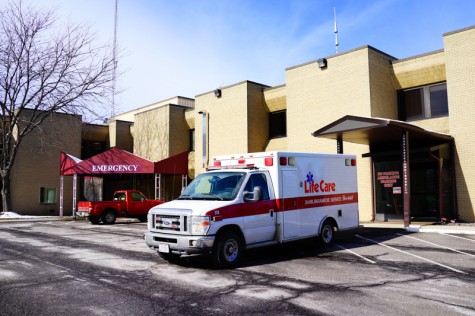Ohio Heroin Epidemic Draws Local, National Attention
February 19, 2016
In a heroin epidemic that is sweeping the nation, Ohio is the second-most-affected state. Ohio senators have recently passed legislation that will work to prevent and treat drug addiction and overdose. Over 2,400 people died from drug overdoses in Ohio in 2014. From 2013 to 2014, there was an 18.3 percent increase in the number of heroin related deaths in Ohio alone.
Ohio Senator Rob Portman is co-sponsor of a bill called The Comprehensive Addiction and Recovery Act. A congressional committee sent it to be reviewed by the House or the Senate on Feb. 11, 2016.

A Life Care ambulance vehicle parked outside of the emergency entrance to Mercy Allen Hospital. Local Senators Rob Portman and Sherrod Brown recently passed legislation that could change the hospital’s heroin policies.
The bill expands efforts to prevent the abuse of opioids and heroin around the nation. It will provide up to $80 million in funding for treatment, prevention and recovery. It also expands resources to identify and treat inmates with addictions by means of evidence-based intervention programs. While there are services and medications available to treat addiction, like Naloxone — a drug that reverses the effects of opioid overdose — there is serious need for training and resources necessary to address the epidemic.
“[The bill] is the most expansive federal, bipartisan legislation to date for addiction support services,” according to the Association for Addiction Professionals website. Additionally, it encourages states to support recovery for individuals who are trying to recover from drug addictions.
In response to the increase in Overdoses, several Ohio pharmacies, including Kroger and CVS, have started selling Naloxone over the counter; they are among the first to do so.
Naloxone, which can be given as a nasal spray, is meant to reverse the effects of opioid overdoses, including extreme drowsiness, slowed breathing and loss of consciousness. Kroger will supply Naloxone in 216 of its locations. On average, Naloxone costs $40.69 for the nasal spray and $52.99 for the injection.
Selling anti-overdose drugs is a relatively new idea, as TIME magazine reported. The FDA first heard the proposal of selling Naloxone over the counter in 2012.
“While [Naloxone] will save lives, reviving someone is just the first step. The hope then is getting them into treatment,” said Senator Portman during a press conference announcing the drug’s arrival in the Krogers statewide.
Other bills have also been proposed in response to the increase in overdoses. Ohio Senator Sherrod Brown introduced his own bill last week, The Heroin and Prescription Drug Abuse Prevention and Reduction Act. His bill is geared more toward preventative measures and the resources needed for successful recoveries to stop relapses.
The Recovery Enhancement for Addiction Treatment Act would update U.S. law to
enable physicians to treat larger numbers of patients struggling with addiction by allowing qualified physicians “to request approval to treat an unlimited number of patients under specified conditions, including that he or she: (1) agrees to fully participate in the Prescription Drug Monitoring Program of the state in which the practitioner is licensed, (2) practices in a qualified practice setting, and (3) has completed at least 24 hours of training regarding treatment and management of opiate-dependent patients for substance use disorders provided by specified organizations,” according to Congress’ website.
It is co-sponsored by Senator Brown and would also allow certain nurse practitioners and physician assistants to provide supervised, medication-assisted treatment for patients.
“Addiction isn’t an individual problem or a character flaw — it’s a chronic disease that, when left untreated, places a massive burden on our healthcare system, our families and communities,” Brown said in a press release. “That’s why I’ve introduced the Heroin and Prescription Drug Abuse Prevention and Reduction Act — a comprehensive solution to address this multifaceted problem. It should not be easier for Ohioans to get their hands on opioids than it is for them to get help to treat their addiction.”
One of the reasons for the recent rise in heroin usage is its low cost and availability compared to other opiates, according to the website of Clarity Detox, an opioid rehab center. Heroin can cost up to $140 a day, while Oxycotin can cost up to $300.
Oberlin has had problems with heroin in the past. In 2013, Director of Safety and Security, Marjorie Burton, released a warning to students on the Oberlin OnCampus blog. The post advised students against a dangerous batch of heroin that was circulating Lorain County, responsible for 21 overdoses and at least three deaths.
In 2014, Oberlin first responders reported 18 overdoses.
The College has a medical amnesty policy in place that will prevent the direct arrest of a student who seeks help relating to instances of illegal drug usage. Heroin users seeking help on campus would not find themselves formally sanctioned unless other college policies were violated.
“It is extremely important that any person in need of medical assistance obtain it promptly at the time it is needed,”Burton said.


















